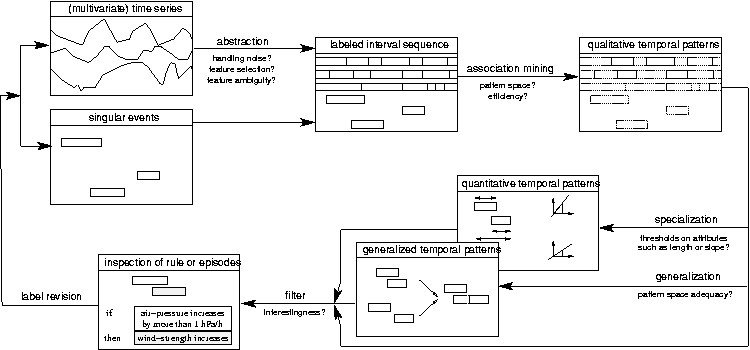Information Engineering Lab

Information Engineering LabF. Höppner, Ostfalia University of Applied Sciences
|
 |
In the DFG project Kl 648/1 we were concerned about the question of how to learn rules about qualitative / semi-quantitative dependencies in multivariate time series (keywords: knowledge discovery from time series, rule discovery in time series, temporal pattern discovery). The approach can be sketched as follows: At the beginning the time series are segmented and thereby transformed into sequences of labeled intervals. The labels denote qualitative aspects of the signal in the respective intervals. Then, from the sequence of labeled intervals, we discover temporal patterns that occur more often than a certain threshold. The temporal patterns are sets of intervals where Allen's interval logic is used to capture their temporal relationships. From these patterns rules can be derived with temporal patterns in the premise and conclusion. Rules may be specialized with respect to numerical attributes like the length of the intervals or the slope of the signal within the interval. Finally, we obtain rules like when signal A decreases while signal B increases with slope greater than 2 then signal C will decrease. Since humans use a similar syntax when discussing such aspects, the proposed methodology may support a human in learning from temporal data. New insights into the examined time series may then be the motivation for extracting different features from the time series and the process is restarted.

The approach can also be applied to sequential data other than time series (for instance biological sequences, medical profiles, etc.). For sequential learning the time series abstraction step has to be replaced by an appropriate procedure that yields a sequence of intervals. Very often no such method is necessary because the data is already in this format (e.g. deseases of a patient, insurance contracts, period in which a certain DNA sequence occurs, etc.).
The figure above depicts the approach graphically. The arrows indicate the processing steps necessary to reach the next representation. Terms with question marks indicate important points that need special attention in the respective step.
The approach utilizes techniques from artificial intelligence, machine learning, data mining and signal processing. This project was funded by the DFG under grant Kl-648.
You can find publications related to temporal patterns below, some of them are available on-line (g'zipped postscript (.ps.gz) and portable document format (.pdf)).